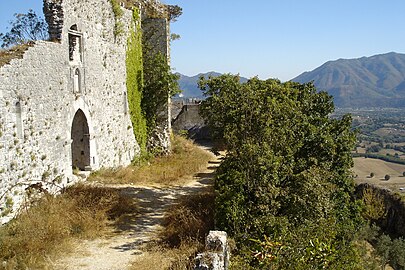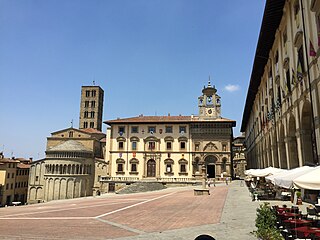
Arezzo is a city and comune in Italy and the capital of the province of the same name located in Tuscany. Arezzo is about 80 kilometres southeast of Florence at an elevation of 296 metres (971 ft) above sea level. In 2013 the population was about 99,000.
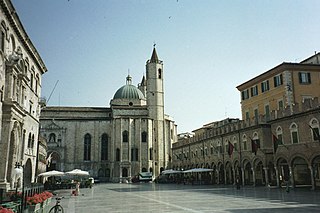
Ascoli PicenoItalian: [ˈaskoli piˈtʃɛːno](listen); Latin: Asculum) is a town and comune in the Marche region of Italy, capital of the province of the same name. Its population is around 48,278 but the urban area of the city has more than 93,000.

Foligno is an ancient town of Italy in the province of Perugia in east central Umbria, on the Topino river where it leaves the Apennines and enters the wide plain of the Clitunno river system. It is located 40 kilometres south-east of Perugia, 10 km (6 mi) north-north-west of Trevi and 6 km (4 mi) south of Spello.

Bracciano is a small town in the Italian region of Lazio, 30 kilometres northwest of Rome. The town is famous for its volcanic lake and for a particularly well-preserved medieval castle Castello Orsini-Odescalchi. The lake is widely used for sailing and is popular with tourists; the castle has hosted a number of events, especially weddings of actors and singers.

The Province of L'Aquila is the largest, most mountainous and least densely populated province of the Abruzzo region of Southern Italy. It comprises about half the landmass of Abruzzo and occupies the western part of the region. It has borders with the provinces of Teramo to the north, Pescara and Chieti to the east, Isernia to the south and Frosinone, Rome and Rieti to the west. Its capital is the city of L'Aquila.

Comacchio is a town and comune of Emilia Romagna, Italy, in the province of Ferrara, 48 kilometres (30 mi) from the provincial capital Ferrara. It was founded about two thousand years ago; across its history it was first governed by the Exarchate of Ravenna, then by the Duchy of Ferrara, and eventually returned to be part of the territories of the Papal States. For its landscape and its history, it is considered one of the major centres of the Po delta.
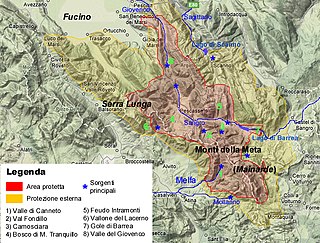
Abruzzo, Lazio and Molise National Park is an Italian national park founded in 1922. The majority of the park is located in the Abruzzo region, with smaller parts in Lazio and Molise. It is sometimes called by its former name Abruzzo National Park. The park headquarters are in Pescasseroli in the Province of L'Aquila. The park's area is 496.80 km2 (191.82 sq mi).

Mirandola is a city and comune of Emilia-Romagna, Italy, in the Province of Modena, 31 kilometres (19 mi) northeast of the provincial capital by railway.

Novi Ligure is a city and comune north of Genoa, in the Piedmont region of the province of Alessandria of northwest Italy.

Pescasseroli is a town and comune in the province of L'Aquila, in Southern Abruzzo, central Italy.

Atessa is an municipality in the province of Chieti, Abruzzo, south-eastern Italy. It is part of the Val di Sangro mountain community. It is the largest municipality in the province by extension and eighth by population.

Penne is an Italian town in the province of Pescara, in the Abruzzo region, in mid-southern Italy. According to the last census in 2014 the population was 12,451. In 2012 Penne was selected as one of the "Most Beautiful Towns of Italy"

Amatrice is a town and comune in the province of Rieti, in northern Lazio, and the center of the food-agricultural area of Gran Sasso e Monti della Laga National Park. The town was devastated by a powerful earthquake on 24 August 2016.

Pescina is a township and comune in the province of L'Aquila, Abruzzo, central Italy. It is a part of the mountain community Valle del Giovenco.

Civitella del Tronto is a town and comune in the province of Teramo, within the Abruzzo region of central Italy. It is in the Gran Sasso e Monti della Laga National Park.
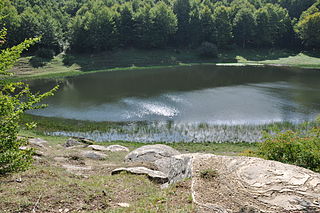
Accumoli is a comune (municipality) in the Province of Rieti in the Italian region Lazio, located about 110 kilometres (68 mi) northeast of Rome and about 45 kilometres (28 mi) northeast of Rieti. It is located in the natural park known as the "Gran Sasso e Monti della Laga National Park".

Picinisco is a comune (municipality) in the Province of Frosinone in the Italian region Lazio, located about 120 kilometres (75 mi) east of Rome and about 45 kilometres (28 mi) east of Frosinone. It is included in the Valle di Comino and National Park of Abruzzo, Lazio e Molise.

Ciociaria is the name by which, starting from the modern era, some impoverished territories southeast of Rome were called at a popular level, without defined geographical limits. Starting from the Fascist period and the creation of the province of Frosinone, the same name was arbitrarily imposed by the local fascist organizations and then misused by the local press, by promotional associations and folkloristic events as a synonym for Frosinone and all the popular traditions of its territory. The local dialect, now improperly known as ciociaro, was historically referred to as campanino. In more recent times, the term Campagna Romana, or Roman Campagna, a favorite subject of countless painters from all over Europe, has referred to the adjoining region to the north of Ciociaria, but part of the Province of Rome.

Valmontone is a comune (municipality) in the Metropolitan City of Rome in the Italian region Lazio, located about 45 kilometres southeast of Rome.

Lorenzo Arnone Sipari is an Italian nature writer and historian, author of many studies on the social and environmental history, especially on the origins and foundation of Parco Nazionale d'Abruzzo.





